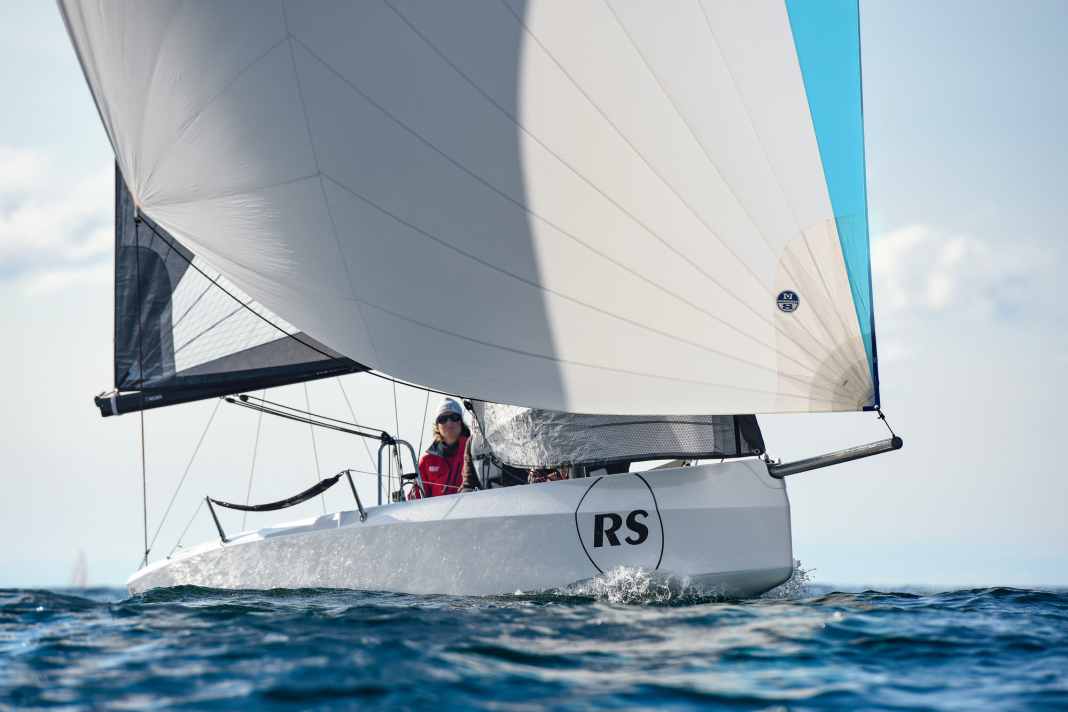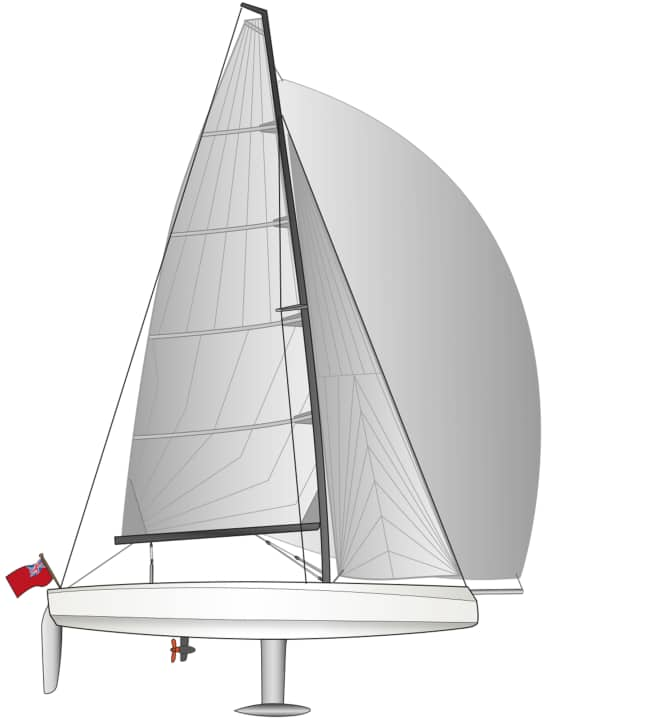RS 21: Successor to the throne of the best-selling J/70 sports boat in the test
Jochen Rieker
· 13.05.2025






You can choose smaller challenges. But there are also smaller shipyards. Strictly speaking, all dinghy manufacturers are smaller than RS Sailing. So as the world market leader, why not attack another world market leader - and save the world at the same time?
This is more or less what the British have in mind with the RS 21 - a design exclusively for speed and competition sailing. It is boldly, if not cheekily, positioned against the best-selling sports boat for years: the J/70 from J/Boats. No other yachtyard has produced anywhere near as many boats of one type since 2012.
This might also interest you:
The RS 21 is intended to build on this. Like the J/70, it is designed as a standardised class for club and league sailing. But it comes quite late. This is because most national and international series are held on the two-foot longer arch-rival, which has long since established itself as the de facto standard in a market segment that is already quite well populated.
"We know that it won't be easy," says Michiel Geerling, responsible for the development of the European market at RS Sailing. "That's why we've worked long and hard to offer a real alternative." In fact, the RS 21 is not just a copy. On the contrary: although its basic concept is close enough to the J/70 to poach in its territory, it remains pleasingly independent and refreshingly innovative.
Sustainable construction
This starts with the construction, which takes environmental aspects into account to a greater extent than any other large-scale shipyard currently does. The 6.34 metre long hull, which is not covered in the foredeck, is built as a GRP sandwich using the vacuum infusion process - like many modern sports boats today. But that is the end of the story.
This is because RS Sailing uses a vinyl ester resin with a high organic content, which is partially obtained from agricultural waste products. The inner foam core is made from recycled PET plastic bottles. And the film used to compress the laminate under vacuum is also reusable.
Even during delivery, the British company pays attention to the environment: instead of wrapping the RS 21 in plastic, it is protected by a cotton cloth; fittings and equipment travel to the customer in cardboard boxes. "We know that not everything we do is perfect," says Michiel Geerling. "But we are constantly trying to improve."
Prices of the RS 21
- Base price ex shipyard: 50,050 € incl. 19% VAT.
- Price with electric motorisation: 54,470 € incl. 19% VAT.
- Guarantee/against osmosis: 2/2 years
Status 2025, how the prices shown are defined, read here!
Consequently, a combustion engine was not an option for the boat, which only displaces 650 kilograms. If you need an auxiliary drive, a Torqeedo Travel 1003 with a 530 ampere lithium-ion battery is available for an extra charge. Its performance is roughly equivalent to a 3 hp outboard motor.
The highlight: instead of hanging at the stern, the genset sits in the centre of the cockpit in a shaft, where it can be completely raised for sailing and trailer transport. The battery is located further forward in the hull for optimum weight trim; the control lever and remaining range indicator are hidden in a recess of the trim console in the cockpit - well protected from lines and unintentional kicks.
At full load, we logged just under 5 knots with the electric motor in the test; however, this only gets you about 3 nautical miles. At 3 knots, on the other hand, the Torqeedo should provide thrust for around 10 miles. This means that the RS 21 can be operated on inland waterways without a special licence.
RS Sailing has also developed a smart solution for transport by road. The hull and deck are designed in such a way that they can be stacked inside each other after dismantling just a few parts. This seems particularly interesting for the organisers of league events and larger club regattas, as a mid-range car can easily hook up two RS 21s. Ultimately, this is also a contribution to environmental protection, which is not only considered very important by the World Sailing Federation, but also by more and more clubs and active participants.
Promising lines
As the pictures show, the boat is otherwise by no means reminiscent of alternative lifestyles. Thankfully, the shipyard has packaged its eco-claim in a very attractive way. The RS 21 looks ultra-modern, even radical, with its low deck chine and negative stem. But that's not really what it's supposed to be.
"It is not a thoroughbred sports boat for highly trained squad sailors," emphasises Michiel Geerling. Rather, it should also be able to be used for training and fun regattas. It is therefore designed to be relatively good-natured. On the one hand, she has a lot of dimensional stability and righting moment (ballast ratio: 47 per cent); on the other hand, her appendages are moderately shaped, with an aspect ratio that is not too extreme, so that they provide good controllability even at slow speeds.
Challenging cockpit layout
Of course, it would be a gross injustice to characterise it as a sheep in wolf's clothing. The binding nature of the design really doesn't go that far. This can be surmised by looking at the keyboards on the outriggers located behind the mast base and on both sides of the trim console in the cockpit. They enable a wide range of fine adjustments. In addition to the usual adjustments such as the backstay, boom vang and luff and foot tensioners for the main, the RS 21 also allows the luff tension of the jib to be adjusted via the halyard and cunningham.
The endless mainsheet even has two foot blocks - one forward, the other aft of the pedestal in which the Torqeedo motor is located. This means that the trimmer and helmsman can tighten the sail together in a gybe, for example, and ease it again, which enables faster manoeuvres, whereas the functions are otherwise carried out separately. During the test, however, the line guidance proved to be stiff in places. In particular, the triple-deflected gennaker sheets could only be retrieved under pressure with a great deal of force.
Sporty temperament
The RS 21 was available to us for two days in the archipelago off Orust in western Sweden - in light to medium conditions. She showed impressive sailing characteristics, especially when tacking.
Even in winds of 12 to 15 knots, in gusts up to 18 knots, she was able to carry a full sail without any problems and was light yet responsive at the helm. In the one-design version with Mylar sails, she reached an average of 6.0 knots at a turning angle of just over 80 degrees - a very good value.
She also proved to be nimble under a 40 square metre top gennaker: 12 knots at the top and 9 to 10 knots over long stretches with manners free of airs and graces - that's fine. She did lack a little explosiveness and lightness. In a standardised class, however, this only plays a minor role because all crews are sailing with identical equipment.
Is that enough to unseat the ubiquitous J/70? All in all, the RS 21 definitely has a chance, especially as it is a good ten per cent cheaper.
YACHT rating of the RS 21
The RS 21 is an attractive sports boat that is fun to sail. However, it still lacks the numbers required for a standardised class.
Design and concept
Sophisticated one-design approach
Innovative details
Sailing performance and trim
Agile, fast, quite stiff
Line guide stiff
Equipment and technology
Well-equipped electric drive (option)
Simple fittings/lines
The RS 21 in detail

Technical data of the RS 21
- Designers: Richards/Whitehouse
- Torso length: 6,34 m
- Width: 2,20 m
- Depth: 1,38 m
- Weight: 0,65 t
- sail area: 24,6 m²
- Sail carrying capacity: 5,7
Hull and deck construction
GRP sandwich with recycled material in the foam core.
Retailer
RS Sailing Germany, e-mail: info@rssailing.de
The test was first published in 2019 and has been revised for this online version.

